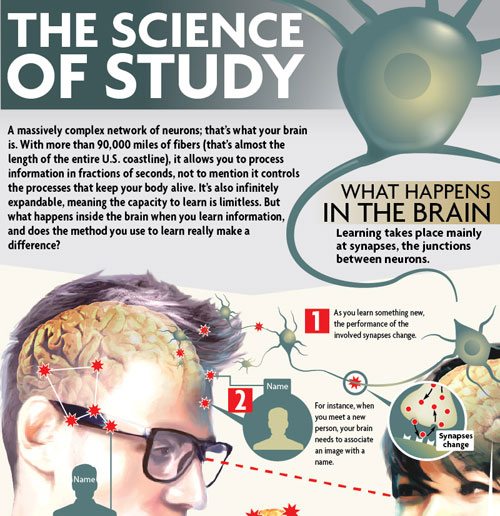The Science of Study
THE SCIENCE OF STUDY
A massively complex network of neurons; that’s what your brain is. With more than 90,000 miles of fibers (that’s almost the length of the entire U.S. coastline), it allows you to process information in fractions of seconds, not to mention it controls the processes that keep your body alive. It’s also infinitely expandable, meaning the capacity to learn is limitless. But what happens inside the brain when you learn information, and does the method you use to learn really make a difference?
What Happens in the Brain
Learning takes place mainly at synapses, the junctions between neurons.
As you learn something new, the performance of the involved synapses change. For instance, when you meet a new person, your brain needs to associate an image with a name. Storage of such information takes place in different parts of your brain, but as you see the new person more and more, the synapses related to the name and image begin firing simultaneously. It’s through this simultaneous firing that you truly learn the new information.
Synchronizing synapses isn’t the only biological effect of learning: When you take on a new, difficult skill or learn a piece of brand-new information, the brain actually becomes larger in size. Such changes are not noticeable on a day-to-day basis, but they can be seen over time.
Mind Your Method
Does the way in which we go about studying really make a difference?
Staying up late
Multiple experiments have shown that staying up late can often be counterproductive. In fact, a Harvard study found fatigue negatively affects the cortex, which stores information in the brain.
A Hendrix College study broke students into three groups (night owls, morning larks and regular robins) and tracked their study/sleep habits for their freshman years.
GPA by group at end of year
Night owl Morning larks Regular robins
2.84 3.18 3.18
Cramming
Cramming often proves effective in the very short term, but those gains tend to vanish as time passes. We perform better when study sessions are spaced out over longer periods of time rather than packed into one sitting.
Testing yourself
Frequent testing of material you’ve just recently been exposed to can also be effective. In a University of Louisville study, a professor tested one class at the end of each lecture with quizzes on what they’d just heard; another class of the professor’s used the same syllabus but did not do the daily quizzes. Students in the quizzed class significantly outscored those in the other class on midterm exams.
Who Studies the Most?
Each academic field of study requires combinations of different study methods. The average weekly hours of study by academic majors may provide insight into which methods students of particular disciplines are utilizing.
Average weekly study hours by academic major
Architecture 23.7
Chemical engineering 21.6
Physics 19.7
Chemistry 18.4
Art 18.1
Nursing 18
Music 17.5
Biology 16.7
Mathematics 16.4
Philosophy 16.2
Theater 16
Anthropology 16
English 15.9
Elementary education 15.2
Accounting 15.1
History 15
Computer science 14.7
Political science 14.6
Economics 14.4
Psychology 13.9
Sociology 13.8
Finance 13.3
Business administration 13.2
Journalism 12.8
Communications 12.5
Marketing 12.1
Physical education 11.8
Leisure studies 11.1
Speech 10.8
SOURCES
http://www.scientificamerican.com/article.cfm?id=how-does-our-brain-learn
http://healthlibrary.brighamandwomens.org/RelatedItems/6,667866
http://www.thebatt.com/opinion/calling-off-cramming-1.1778158#.UbjT25_C8ak
http://www.time.com/time/health/article/0,8599,1903838,00.html
http://www.popsci.com/scitech/article/2008-11/cramming-not-long-term-study-strategy
http://www.apa.org/gradpsych/2011/11/study-smart.aspx
http://www.washingtonpost.com/local/education/number-of-hours-students-study/2012/05/21/gIQA3viTgU_graphic.html


